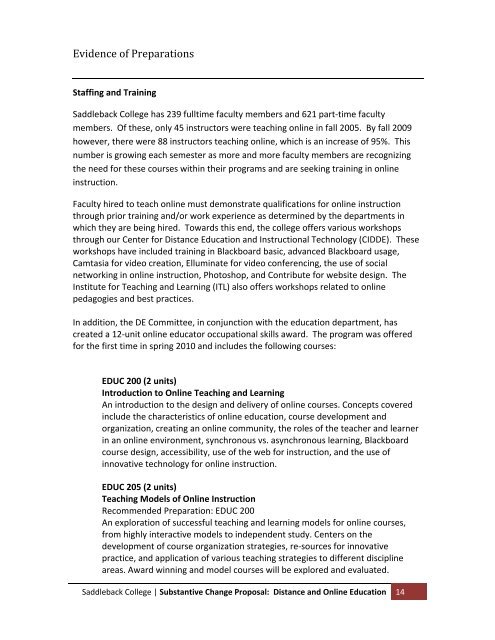Substantive Change Proposal - Saddleback College
Substantive Change Proposal - Saddleback College
Substantive Change Proposal - Saddleback College
You also want an ePaper? Increase the reach of your titles
YUMPU automatically turns print PDFs into web optimized ePapers that Google loves.
Evidence of Preparations<br />
Staffing and Training<br />
<strong>Saddleback</strong> <strong>College</strong> has 239 fulltime faculty members and 621 part‐time faculty<br />
members. Of these, only 45 instructors were teaching online in fall 2005. By fall 2009<br />
however, there were 88 instructors teaching online, which is an increase of 95%. This<br />
number is growing each semester as more and more faculty members are recognizing<br />
the need for these courses within their programs and are seeking training in online<br />
instruction.<br />
Faculty hired to teach online must demonstrate qualifications for online instruction<br />
through prior training and/or work experience as determined by the departments in<br />
which they are being hired. Towards this end, the college offers various workshops<br />
through our Center for Distance Education and Instructional Technology (CIDDE). These<br />
workshops have included training in Blackboard basic, advanced Blackboard usage,<br />
Camtasia for video creation, Elluminate for video conferencing, the use of social<br />
networking in online instruction, Photoshop, and Contribute for website design. The<br />
Institute for Teaching and Learning (ITL) also offers workshops related to online<br />
pedagogies and best practices.<br />
In addition, the DE Committee, in conjunction with the education department, has<br />
created a 12‐unit online educator occupational skills award. The program was offered<br />
for the first time in spring 2010 and includes the following courses:<br />
EDUC 200 (2 units)<br />
Introduction to Online Teaching and Learning<br />
An introduction to the design and delivery of online courses. Concepts covered<br />
include the characteristics of online education, course development and<br />
organization, creating an online community, the roles of the teacher and learner<br />
in an online environment, synchronous vs. asynchronous learning, Blackboard<br />
course design, accessibility, use of the web for instruction, and the use of<br />
innovative technology for online instruction.<br />
EDUC 205 (2 units)<br />
Teaching Models of Online Instruction<br />
Recommended Preparation: EDUC 200<br />
An exploration of successful teaching and learning models for online courses,<br />
from highly interactive models to independent study. Centers on the<br />
development of course organization strategies, re‐sources for innovative<br />
practice, and application of various teaching strategies to different discipline<br />
areas. Award winning and model courses will be explored and evaluated.<br />
<strong>Saddleback</strong> <strong>College</strong> | <strong>Substantive</strong> <strong>Change</strong> <strong>Proposal</strong>: Distance and Online Education 14
















